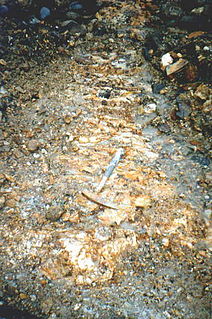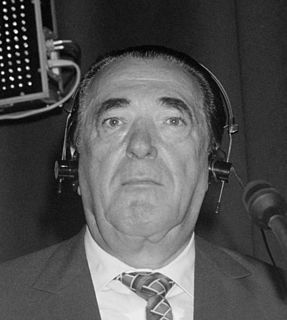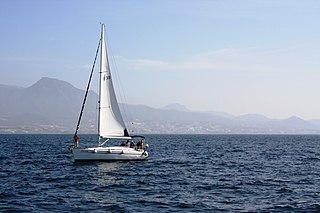A creditor is a party that has a claim on the services of a second party. It is a person or institution to whom money is owed. The first party, in general, has provided some property or service to the second party under the assumption that the second party will return an equivalent property and service. The second party is frequently called a debtor or borrower. The first party is called the creditor, which is the lender of property, service, or money.
A floating charge is a security interest over a fund of changing assets of a company or other artificial person. Unlike a fixed charge, which is created over ascertained and definite property, a floating charge is created over property of an ambulatory and shifting nature. Examples of such property are receivables and stocks. The floating charge The floating charge 'floats' or 'hovers' until the point at which it is converted into a fixed charge. Once it becomes a "fixed charge" the charge attaches to the specific assets of the business. This conversion of the floating charge into a fixed charge can trigger common law jurisdictions]] it is an implied term in security documents creating floating charges that a cessation of the company's right to deal with the assets in the ordinary course of business leads to automatic crystallisation. Additionally, security documents will usually include express terms that a default by the person granting the security will trigger crystallisation.

Tracing is a legal process, not a remedy, by which a claimant demonstrates what has happened to his/her property, identifies its proceeds and those persons who have handled or received them, and asks the court to award a proprietary remedy in respect of the property, or an asset substituted for the original property or its proceeds. Tracing allows transmission of legal claims from the original assets to either the proceeds of sale of the assets or new substituted assets.

Barclays Bank Ltd v Quistclose Investments Ltd [1968] UKHL 4 is a leading property, unjust enrichment and trusts case, which invented a new species of proprietary interest in English law. A "Quistclose trust" arises when an asset is given to somebody for a specific purpose and if, for whatever reason, the purpose for the transfer fails, the transferor may take back the asset.
Devaynes v Noble (1816) 35 ER 781, best known for the claim contained in Clayton's case, created a rule, or rather common law presumption, in relation to the distribution of monies from a bank account. The rule is based upon the deceptively simple notion of first-in, first-out to determine the effect of payments from an account, and normally applies in English Law in the absence of evidence of any other intention. Payments are presumed to be appropriated to debts in the order in which the debts are incurred.

English trust law concerns the creation and protection of asset funds, which are usually held by one party for another's benefit. Trusts were a creation of the English law of property and obligations, but also share a history with countries across the Commonwealth and the United States. Trusts developed when claimants in property disputes were dissatisfied with the common law courts and petitioned the King for a just and equitable result. On the King's behalf, the Lord Chancellor developed a parallel justice system in the Court of Chancery, commonly referred as equity. Historically, trusts were mostly used where people left money in a will, created family settlements, created charities, or some types of business venture. After the Judicature Act 1873, England's courts of equity and common law were merged, and equitable principles took precedence. Today, trusts play an important role in financial investments, especially in unit trusts and pension trusts, where trustees and fund managers usually invest assets for people who wish to save for retirement. Although people are generally free to write trusts in any way they like, an increasing number of statutes are designed to protect beneficiaries, or regulate the trust relationship, including the Trustee Act 1925, Trustee Investments Act 1961, Recognition of Trusts Act 1987, Financial Services and Markets Act 2000, Trustee Act 2000, Pensions Act 1995, Pensions Act 2004 and the Charities Act 2011.
Re D’Jan of London Ltd [1994] 1 BCLC 561 is a leading English company law case, concerning a director's duty of care and skill, whose main precedent is now codified under s 174 of the Companies Act 2006. The case was decided under the older Companies Act 1985.

United Kingdom insolvency law regulates companies in the United Kingdom which are unable to repay their debts. While UK bankruptcy law concerns the rules for natural persons, the term insolvency is generally used for companies formed under the Companies Act 2006. "Insolvency" means being unable to pay debts. Since the Cork Report of 1982, the modern policy of UK insolvency law has been to attempt to rescue a company that is in difficulty, to minimise losses and fairly distribute the burdens between the community, employees, creditors and other stakeholders that result from enterprise failure. If a company cannot be saved it is "liquidated", so that the assets are sold off to repay creditors according to their priority. The main sources of law include the Insolvency Act 1986, the Insolvency Rules 1986 ), the Company Directors Disqualification Act 1986, the Employment Rights Act 1996 Part XII, the Insolvency Regulation (EC) 1346/2000 and case law. Numerous other Acts, statutory instruments and cases relating to labour, banking, property and conflicts of laws also shape the subject.
Tracing in English law is a procedure to identify property that has been taken from the claimant involuntarily. It is not in itself a way to recover the property, but rather to identify it so that the courts can decide what remedy to apply. The procedure is used in several situations, broadly demarcated by whether the property has been transferred because of theft, breach of trust, or mistake.

Oldham v Kyrris [2003] EWCA Civ 1506 is a UK insolvency law case concerning the administration procedure when a company is unable to repay its debts.

Foskett v McKeown [2000] UKHL 29 is a leading case on the English law of trusts, concerning tracing and the availability of proprietary relief following a breach of trust.
Vaughan v Barlow Clowes International Ltd [1991] EWCA Civ 11 is an English trusts law case, concerning tracing.

Re Hallett’s Estate (1880) 13 Ch D 696 is an English trusts law case, concerning asset tracing.
Sir Andrew Peter Leggatt, PC was formerly a Lord Justice of Appeal and member of the Privy Council.
Administration in United Kingdom law refers to the main kind of procedure in UK insolvency law when a company is unable to pay its debts. The management of the company is usually replaced by an insolvency practitioner whose statutory duty is to rescue the company, save the business, or get the best result possible. It is the equivalent of Chapter 11, Title 11, United States Code, although with significant differences. While creditors with a security interest over all a company's assets could control the procedure previously through receivership, the Enterprise Act 2002 made administration the main procedure.
Sir George Brian Hugh Dillon was a British lawyer and judge who served as a Lord Justice of Appeal from 1982 to 1994.
Sir Denis Maurice Henry, PC was an English barrister, Queen's Counsel and judge, rising to Lord Justice of Appeal. He presided over the Guinness share-trading fraud, a major British business scandal of the 1980s.

Re Nanwa Gold Mines Ltd [1955] 1 WLR 880 was a trust law decision relating to subscription monies for shares and what would subsequently come to be known as Quistclose trusts. The court held that where subscription monies had been paid over to enable the company to accomplish a specific purpose, if that purpose failed then the money was held on trust for the subscribers and did not form part of the assets of the company. Even though the decision was only a first-instance ex tempore decision, it has been repeatedly upheld, including by the House of Lords in Barclays Bank Ltd v Quistclose Investments Ltd [1968] UKHL 4

Re Peachdart Ltd [1984] Ch 131 is a judicial decision relating to retention of title clauses, and the extent to which the vendor of raw material can seek to assert title to good into which those raw materials are subsequently worked. The court held that seeking to assert title to the subsequently worked goods had the effect of creating an equitable charge, which was void for non-registration under the Companies Act.











